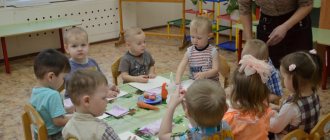Charging in the middle group
Children 4-5 years old are already well acquainted with the principle of performing exercises. The teacher’s attention is focused on the quality and correctness of the movements: clarity and rhythm are maintained, the child should not lag behind the general rhythm and be able to perform the complex efficiently. Children in the middle group do not learn exercises during exercise. The teacher shows how to perform a particular exercise, and the children repeat the movements after the teacher.
During the gymnastics, the teacher can make comments aimed at the correct position of the legs or back; special attention is paid to breathing during the lesson. Children should do the exercises at the same time, guided by counting.
The introductory part includes jumps and side gallop. The motor density of charging should be high, since a short period of time is allotted for it, and you need to have time to complete all the exercises several times.
Preparatory group for school
The set of exercises for children 6–7 years old does not differ much from the previous age group. The teacher already requires clarity and excellent quality of exercises from children. The guys must not only perform the movements, but also know the starting position and intermediate positions. The muscles should feel tense.
Much attention is paid to posture and strengthening the back muscles, because the children will soon go to school and will spend a lot of time at school desks and preparing homework. To avoid curvature of the spine, you need to have strong and developed back muscles.
Children's morning exercises provide a great mood and give a charge of vigor for the whole day, help to liberate shy and indecisive children, and discipline spoiled and overexcited children. During morning exercises, children calm down faster after saying goodbye to their parents and tune in to a certain kindergarten routine.
Gymnastics for younger children
Exercises for the little ones are carried out daily throughout the year, its duration is no more than 5 minutes. The purpose of morning exercises in the younger group is to switch the children’s attention to joint activities. It is necessary to understand that it is quite difficult to implement organized exercises for children, because at this age children often get confused and do not keep up with others. Therefore, gymnastics here consists of three classes: walking, running and jumping.
First you need to get the children's attention. To do this, they should be given a task in the form of short-term walking, which must be alternated with slow running and formation. An excellent solution would be to form a circle. Here you can begin exercises to strengthen your muscles and limbs.
Of course, there is no need to overload the kids; a few minutes of practice will be enough. During exercises, you should definitely use a game element that will help win the child’s attention.
Charging components
- Introductory part. First, children walk in a circle, then begin to perform simple movements while walking, for example: walking on their toes with their hands on their belts; walking on your heels with your hands behind your head; walking like a horse with high knees; walking in single file. Next - easy jogging. The introductory part ends with walking and changing lanes. Children of younger groups stop to perform basic exercises in a circle. Children of older groups can form 2 or 3 columns or ranks.
- Main part. General developmental exercises for all muscle groups. Morning exercises begin with training the shoulder girdle, then the muscles of the back and pelvis are involved. Next, exercises are performed for the legs and feet, including squats and jumps.
- Final part. Its goal is to restore breathing. The guys do breathing exercises either on the spot or while walking in a circle.
Preparing to charge
Morning exercises begin with formation in a column. There is a set of exercises without sports equipment, but more often teachers give the children flags or plumes, blocks from a plastic construction set or balls, gymnastic sticks or rattles. The kids are given attributes in advance, and older preschoolers independently take turns sorting the objects from special containers. Sometimes the teacher appoints a person on duty who distributes sports equipment to his comrades.
The cubes can be laid out on the floor so that after the first part of the exercise, children stop near them to perform a set of basic exercises. Before use, the teacher must check the technical condition of the items used so that they are completely safe for children.
Motivating a child for morning exercises
In addition to the game theme, the teacher can use other techniques to invite children to exercise. Expressive language, interesting content and positive emotions will help motivate children. You can play it so that they themselves want to do physical exercises in order to be fitter and stronger.
You can set up for morning exercises using a general action. For example, a teacher can invite all the children to visit a fairy-tale character. To get there, you need to jump three times and smile. This element of the game will interest the kids, and they will certainly fulfill the conditions. At this age, all children are very inquisitive. They want to understand how animals move, flowers grow, and what happens in the world around them. Experienced educators use this to come up with physical exercises. Children will play sports and learn something new at the same time.
Where does charging take place?
In the warm season, morning exercises are carried out outside, on the territory of the group. With older children, jogging is sometimes organized around the kindergarten building or in a designated area. During the cold season, morning exercises are performed in a group or in a gym. If the kindergarten does not have a specially designated room for physical education, then time is allocated for exercise in the assembly hall. Twice a week, many preschool institutions organize morning exercises with musical accompaniment. Rhythmic activities develop a sense of tact and an ear for music.



